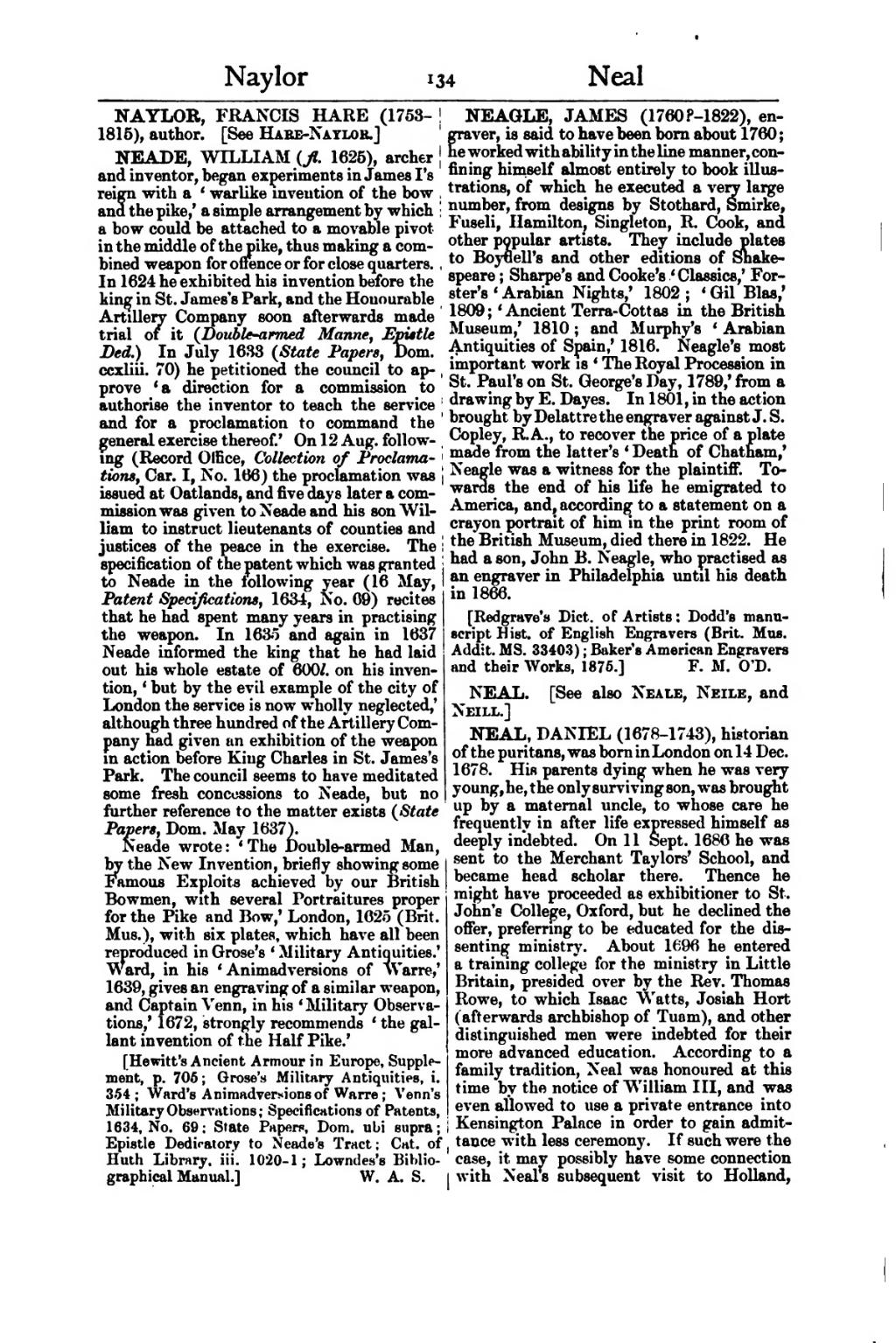NAYLOR, FRANCIS HARE (1753–1815), author. [See Hare-Naylor.]
NEADE, WILLIAM (fl. 1625), archer and inventor, began experiments in James I's reign with a ‘warlike invention of the bow and the pike,’ a simple arrangement by which a bow could be attached to a movable pivot in the middle of the pike, thus making a combined weapon for offence or for close quarters. In 1624 he exhibited his invention before the king in St. James's Park, and the Honourable Artillery Company soon afterwards made trial of it (Double-armed Manne, Epistle Ded.) In July 1633 (State Papers, Dom. ccxliii. 70) he petitioned the council to approve ‘a direction for a commission to authorise the inventor to teach the service and for a proclamation to command the general exercise thereof.’ On 12 Aug. following (Record Office, Collection of Proclamations, Car. I, No. 166) the proclamation was issued at Oatlands, and five days later a commission was given to Neade and his son William to instruct lieutenants of counties and justices of the peace in the exercise. The specification of the patent which was granted to Neade in the following year (16 May, Patent Specifications, 1634, No. 69) recites that he had spent many years in practising the weapon. In 1635 and again in 1637 Neade informed the king that he had laid out his whole estate of 600l. on his invention, ‘but by the evil example of the city of London the service is now wholly neglected,’ although three hundred of the Artillery Company had given an exhibition of the weapon in action before King Charles in St. James's Park. The council seems to have meditated some fresh concessions to Neade, but no further reference to the matter exists (State Papers, Dom. May 1637).
Neade wrote: ‘The Double-armed Man, by the New Invention, briefly showing some Famous Exploits achieved by our British Bowmen, with several Portraitures proper for the Pike and Bow,’ London, 1625 (Brit. Mus.), with six plates, which have all been reproduced in Grose's ‘Military Antiquities.’ Ward, in his ‘Animadversions of Warre,’ 1639, gives an engraving of a similar weapon, and Captain Venn, in his ‘Military Observations,’ 1672, strongly recommends ‘the gallant invention of the Half Pike.’
[Hewitt's Ancient Armour in Europe, Supplement, p. 705; Grose's Military Antiquities, i. 354; Ward's Animadversions of Warre; Venn's Military Observations; Specifications of Patents, 1634, No. 69; State Papers, Dom. ubi supra; Epistle Dedicatory to Neade's Tract; Cat. of Huth Library, iii. 1020–1; Lowndes's Bibliographical Manual.]
NEAGLE, JAMES (1760?–1822), engraver, is said to have been born about 1760; he worked with ability in the line manner, confining himself almost entirely to book illustrations, of which he executed a very large number, from designs by Stothard, Smirke, Fuseli, Hamilton, Singleton, R. Cook, and other popular artists. They include plates to Boydell's and other editions of Shakespeare; Sharpe's and Cooke's ‘Classics,’ Forster's ‘Arabian Nights,’ 1802; ‘Gil Blas,’ 1809; ‘Ancient Terra-Cottas in the British Museum,’ 1810; and Murphy's ‘Arabian Antiquities of Spain,’ 1816. Neagle's most important work is ‘The Royal Procession in St. Paul's on St. George's Day, 1789,’ from a drawing by E. Dayes. In 1801, in the action brought by Delattre the engraver against J. S. Copley, R.A., to recover the price of a plate made from the latter's ‘Death of Chatham,’ Neagle was a witness for the plaintiff. Towards the end of his life he emigrated to America, and, according to a statement on a crayon portrait of him in the print room of the British Museum, died there in 1822. He had a son, John B. Neagle, who practised as an engraver in Philadelphia until his death in 1866.
[Redgrave's Dict. of Artists; Dodd's manuscript Hist. of English Engravers (Brit. Mus. Addit. MS. 33403); Baker's American Engravers and their Works, 1875.]
NEAL. [See also Neale, Neile, and Neill.]
NEAL, DANIEL (1678–1743), historian of the puritans, was born in London on 14 Dec. 1678. His parents dying when he was very young, he, the only surviving son, was brought up by a maternal uncle, to whose care he frequently in after life expressed himself as deeply indebted. On 11 Sept. 1686 he was sent to the Merchant Taylors' School, and became head scholar there. Thence he might have proceeded as exhibitioner to St. John's College, Oxford, but he declined the offer, preferring to be educated for the dissenting ministry. About 1696 he entered a training college for the ministry in Little Britain, presided over by the Rev. Thomas Rowe, to which Isaac Watts, Josiah Hort (afterwards archbishop of Tuam), and other distinguished men were indebted for their more advanced education. According to a family tradition, Neal was honoured at this time by the notice of William III, and was even allowed to use a private entrance into Kensington Palace in order to gain admittance with less ceremony. If such were the case, it may possibly have some connection with Neal's subsequent visit to Holland,
